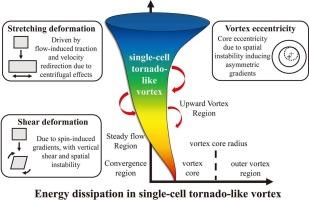Strain-resolved analysis of energy dissipation mechanisms in single-cell tornado-like vortices
IF 2.6
3区 工程技术
Q2 ENGINEERING, MECHANICAL
International Journal of Heat and Fluid Flow
Pub Date : 2025-08-30
DOI:10.1016/j.ijheatfluidflow.2025.110018
引用次数: 0
Abstract
Energy dissipation is crucial in fluid dynamics, especially in swirl flow systems known for their high energy intensity. Their flow behavior is widely studied, both as natural phenomena and in industrial applications. However, its mechanism in terms of energy is not investigated in sufficient depth. In this study, a numerical model of tornado-like vortices is developed using a self-constructed simulator and validated with high-precision experimental data. An energy loss model is employed to visualize energy dissipation and analyze its distribution and underlying mechanisms.
The results show that energy dissipation is primarily concentrated in the lower vortex core, with a viscous-to-turbulent dissipation ratio of 9:16. In particular, energy dissipation is closely related to fluid strain induced by stretching and shear deformations. During vortex formation, flow-induced traction and flow redirection due to centrifugal effects enhance velocity gradients, thereby increasing stretching deformation and energy dissipation. Moreover, horizontal shear deformation, driven by tangential velocity gradients in the vortex core, and vertical shear deformation arising from velocity gradients at the inner-outer vortex boundary, further intensify energy dissipation. Additionally, vortex eccentricity, a feature of spatial instability, results in uneven velocity gradient distribution, exacerbating dissipation. These findings provide novel insights into the energy dissipation mechanisms of tornado-like vortices and deepen the understanding of vortex dynamics.

单细胞类龙卷风涡旋能量耗散机制的应变分辨分析
在流体动力学中,能量耗散是至关重要的,特别是在以高能量强度著称的旋流系统中。它们的流动特性被广泛研究,无论是作为自然现象还是在工业应用中。然而,对其能量机制的研究还不够深入。本文利用自建的模拟装置建立了类龙卷风涡的数值模型,并用高精度的实验数据进行了验证。利用能量损失模型对能量耗散进行可视化,分析能量耗散的分布和机制。结果表明:能量耗散主要集中在低涡核,粘湍耗散比为9:16;特别是,能量耗散与拉伸和剪切变形引起的流体应变密切相关。在涡旋形成过程中,由于离心效应引起的流致牵引和流重定向使速度梯度增大,从而增加了拉伸变形和能量耗散。此外,涡核切向速度梯度驱动的水平剪切变形和内外涡边界速度梯度驱动的垂直剪切变形进一步加剧了能量耗散。此外,涡旋偏心的空间不稳定性导致速度梯度分布不均匀,加剧了耗散。这些发现为研究类龙卷风涡旋的能量耗散机制提供了新的见解,并加深了对涡旋动力学的理解。
本文章由计算机程序翻译,如有差异,请以英文原文为准。
求助全文
约1分钟内获得全文
求助全文
来源期刊

International Journal of Heat and Fluid Flow
工程技术-工程:机械
CiteScore
5.00
自引率
7.70%
发文量
131
审稿时长
33 days
期刊介绍:
The International Journal of Heat and Fluid Flow welcomes high-quality original contributions on experimental, computational, and physical aspects of convective heat transfer and fluid dynamics relevant to engineering or the environment, including multiphase and microscale flows.
Papers reporting the application of these disciplines to design and development, with emphasis on new technological fields, are also welcomed. Some of these new fields include microscale electronic and mechanical systems; medical and biological systems; and thermal and flow control in both the internal and external environment.
 求助内容:
求助内容: 应助结果提醒方式:
应助结果提醒方式:


